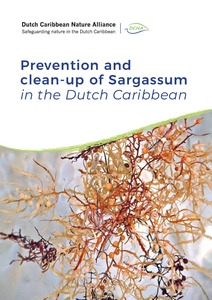Prevention and clean-up of Sargassum in the Dutch Caribbean.

View/
Average rating
votes
Date
2019Corporate Author
Dutch Caribbean Nature Alliance
Status
PublishedPages
30pp.
Metadata
Show full item recordAbstract
In 2011, the shores of several Caribbean islands and West African countries were inundated by unprecedented
quantities of pelagic sargassum. Since then, influxes of this golden-brown seaweed have become
a recurrent event in both the Caribbean Sea and West Africa, with observers in these regions reporting
levels reaching a critical high in 2018” (Hinds et al., 2016). Some piles of stranded sargassum towered
several meters high on beaches, and affected bays were covered with dense floating clusters of
the seaweed. Finding ways to clean-up sargassum from coastal ecosystems has become a priority
for the region. The recent and likely recurring seaweed influxes have given rise to a number of
socio-ecological and economic concerns, particularly in the hospitality and fisheries sectors, as
well as threatening already fragile and often endangered coastal ecosystems such as mangroves
and seagrass beds. The good news is that these negative effects do not seem to persist when the
sargass.....
Resource URL
https://www.dcnanature.org/Publisher
Dutch Caribbean Nature AllianceBonaire, Dutch Caribbean
Document Language
enSustainable Development Goals (SDG)
14.2Essential Ocean Variables (EOV)
Macroalgal canopy cover and compositionBest Practice Type
Best PracticeManual (incl. handbook, guide, cookbook etc)
Spatial Coverage
Caribbean SeaDutch Caribbean
Citation
Dutch Caribbean Nature Alliance (2019) Prevention and clean-up of Sargassum in the Dutch Caribbean. Bonaire, Dutch Caribbean, Dutch Caribbean Nature Alliance, 30pp. DOI: http://dx.doi.org/10.25607/OBP-796Collections
 Repository of community practices in Ocean Research, Applications and Data/Information Management
Repository of community practices in Ocean Research, Applications and Data/Information Management